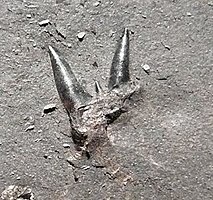オルタカントゥス
表示
| オルタカントゥス | |||||||||||||||||||||||||||
|---|---|---|---|---|---|---|---|---|---|---|---|---|---|---|---|---|---|---|---|---|---|---|---|---|---|---|---|
 Orthacanthus platypterusとO. bohemicusの幼体の化石の解釈図
| |||||||||||||||||||||||||||
| 分類 | |||||||||||||||||||||||||||
| |||||||||||||||||||||||||||
| 学名 | |||||||||||||||||||||||||||
| Orthacanthus Agassiz, 1843 | |||||||||||||||||||||||||||
| 種 | |||||||||||||||||||||||||||
|
オルタカントゥス Orthacanthus は、古代鮫として知られるゼナカントゥス目の淡水性のサメの属の一つ。この属は頭骨の後ろから伸びる長い棘と、ウナギのように非常に長い尾鰭が特徴である。学名は「まっすぐな棘」を意味する[1]。オルサカンサスとも表される。
約2億6000万年前、オルタカントゥスはヨーロッパや北米の淡水沼の生態系の頂点の捕食者であった。全長は約3mでサメ類にはよく見られるように歯は二重の牙になっていた。石炭紀後期からペルム紀前期まで知られる[2]。
共食い
[編集]Aodhanらの2016年の調査で、オルタカントゥスの幼体の歯が成体の糞石中に見いだされたことから、彼らは飢餓の時に共食いをした可能性があることが明らかになった[3][4]。
画像
[編集]出典
[編集]- ^ Gogáin, Aodhán Ó; Falcon-Lang, Howard J.; Carpenter, David K.; Miller, Randall F.; Benton, Michael J.; Pufahl, Peir K.; Ruta, Marcello; Davies, Thomas G. et al. (11 August 2016). “Data from: Fish and tetrapod communities across a marine to brackish salinity gradient in the Pennsylvanian (early Moscovian) Minto Formation of New Brunswick, Canada, and their palaeoecological and palaeogeographical implications”. Palaeontology. ISSN 1475-4983.
- ^ Beck, Kimberly G.; Soler-Gijón, Rodrigo; Carlucci, Jesse R.; Willis, Ray E. (2016-12). “Morphology and Histology of Dorsal Spines of the Xenacanthid Shark Orthacanthus platypternus from the Lower Permian of Texas, USA: Palaeobiological and Palaeoenvironmental Implications”. Acta Palaeontologica Polonica 61 (1): 97–117. doi:10.4202/app.00126.2014. ISSN 0567-7920.
- ^ http://www.businessinsider.com/ancient-sharks-were-cannibals-2016-8
- ^ http://www.eurekalert.org/pub_releases/2016-08/tcd-utc081016.php


